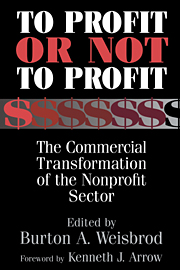Book contents
- Frontmatter
- Contents
- List of contributors
- Foreword by Kenneth J. Arrow
- Preface
- 1 The nonprofit mission and its financing: Growing links between nonprofits and the rest of the economy
- Part I Basic issues and perspective
- 2 Competition, commercialization, and the evolution of nonprofit organizational structures
- 3 Modeling the nonprofit organization as a multiproduct firm: A framework for choice
- 4 Pricing and rationing by nonprofit organizations with distributional objectives
- 5 Differential taxation of nonprofits and the commercialization of nonprofit revenues
- 6 Interdependence of commercial and donative revenues
- 7 Conversion from nonprofit to for-profit legal status: Why does it happen and should anyone care?
- Part II Industry studies
- Part III Overview, conclusions, and public-policy issues
- Appendix: IRS Forms 990 and 990-T for nonprofit organizations
- References
- Index
7 - Conversion from nonprofit to for-profit legal status: Why does it happen and should anyone care?
Published online by Cambridge University Press: 30 November 2009
- Frontmatter
- Contents
- List of contributors
- Foreword by Kenneth J. Arrow
- Preface
- 1 The nonprofit mission and its financing: Growing links between nonprofits and the rest of the economy
- Part I Basic issues and perspective
- 2 Competition, commercialization, and the evolution of nonprofit organizational structures
- 3 Modeling the nonprofit organization as a multiproduct firm: A framework for choice
- 4 Pricing and rationing by nonprofit organizations with distributional objectives
- 5 Differential taxation of nonprofits and the commercialization of nonprofit revenues
- 6 Interdependence of commercial and donative revenues
- 7 Conversion from nonprofit to for-profit legal status: Why does it happen and should anyone care?
- Part II Industry studies
- Part III Overview, conclusions, and public-policy issues
- Appendix: IRS Forms 990 and 990-T for nonprofit organizations
- References
- Index
Summary
Introduction: Conversion as the ultimate commercialism?
If to behave commercially is to act like a for-profit firm, then the ultimate expression of commercialism for a nonprofit is to convert its legal status to the for-profit form. Conversion is increasingly common, most notably in health care, and is now attracting considerable public attention. Some observers believe that nonprofits and for-profits inevitably behave in fundamentally different ways, and question whether conversions can ever serve the public interest. Others are more concerned about the terms, arguing that public assets must remain devoted to the purpose for which nonprofit status was originally granted, and not be redirected toward private gain.
This chapter seeks to advance understanding of nonprofit conversions and their public-policy implications. To set the stage, we introduce some key issues by reviewing briefly conversion activity in health care. We then consider the concept of conversion more closely, discussing various means of transferring control of nonprofit assets. Next we explore the possible motives for conversion, and speculate about the reasons for the rampant conversion activity in health care. Finally, we discuss at some length the important public-policy questions raised by conversions. In our view, the most important are the following:
Under what circumstances is conversion appropriate?
How should the nonprofit's assets be valued? and
What should happen to the financial assets that remain after the conversion?
- Type
- Chapter
- Information
- To Profit or Not to ProfitThe Commercial Transformation of the Nonprofit Sector, pp. 129 - 148Publisher: Cambridge University PressPrint publication year: 1998
- 3
- Cited by



